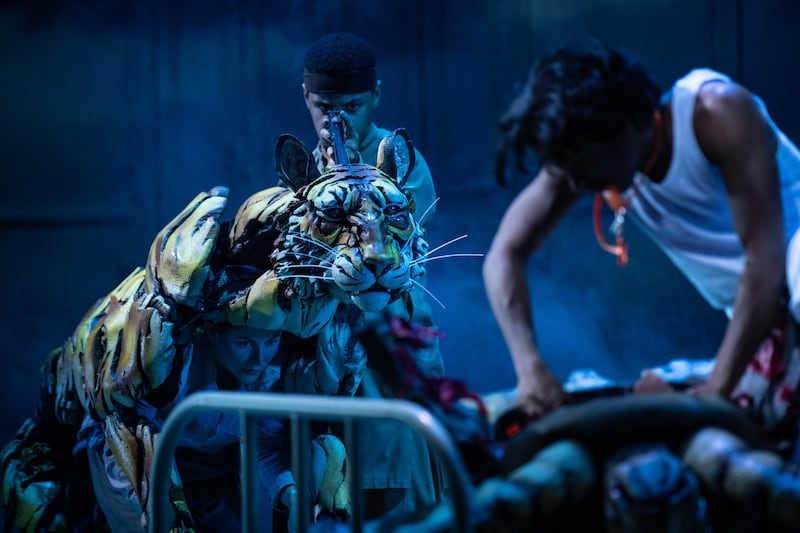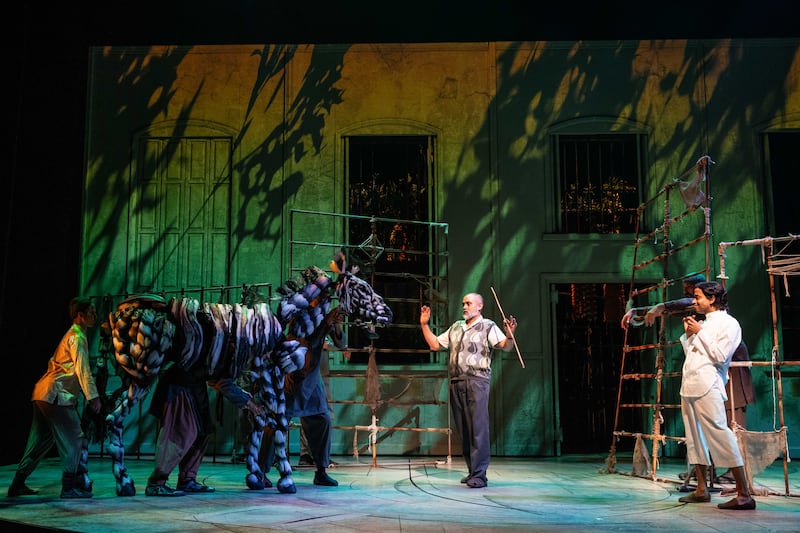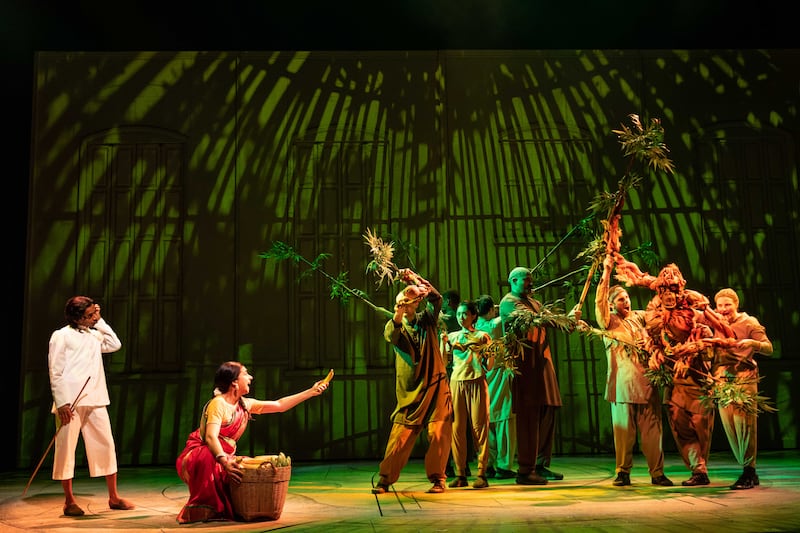At the Laurence Olivier theatre awards in London a couple of years ago, the prize for best supporting actor went to the seven performers playing Richard Parker in Lolita Chakrabarti’s stage adaptation of Life of Pi, the novel by Yann Martel. It was the first time that a collective of actors was celebrated instead of one, and the first time the accolade recognised the performance of a character embodied by a puppet: Richard Parker is the unusually named Bengal tiger that accompanies Pi, a young Indian boy, on his journey across the Pacific Ocean in a rowing boat.
Life of Pi, which arrives in Ireland this month, won five awards that night. It’s no surprise that one of them went to the creators of the tiger and of all the other puppets that anchor the story, Nick Barnes and Finn Caldwell. The pair met after Caldwell, who had acted with top British companies such as Cheek by Jowl and the Royal Shakespeare Company, began to fall out of love with performing.
He’d enjoyed the mask work and physical-theatre practice of his training at the Guildhall School of Music & Drama, so began “looking around for companies and types of work I wanted to emulate and be involved with”. Most of the physical theatre and puppetry he saw turned out to be “really bad and not very rigorous”. Still, inspired, he thought it might be something he could change.
It’s an incredibly different type of acting task, to be able to hold on to a story without the use of text
— Finn Caldwell
It was during an encounter with the work of Blind Summit, who take their inspiration from the bunraku traditions of Japan, where puppeteers are visible to the audience, that he met Barnes, a puppet designer, and together they began experimenting with the way puppets could take on a full acting role, “where the puppet would have a real stake in things, the same as any other role”.
READ MORE
Caldwell’s breakthrough came when he was hired to work on the UK National Theatre’s award-winning staging of War Horse. The production, whose main character is Joey, a 30kg horse embodied by three performers, “needed someone very fit and strong” to work the intricate puppet. Someone, as Caldwell explains, “who understood what it is for a puppet to hold a narrative, to hold the audience’s attention for hours at time without talking, who knows how to show what [Joey] wants and needs and what he is frightened of… It’s an incredibly different type of acting task, to be able to hold on to a story without the use of text.”
Caldwell became one of Joey’s animators, as well as associate puppeteer director of the production. It was, he says, a mind-blowing experience. “What we achieved with the horse in War Horse, you couldn’t make a real horse go through those detailed changes that we made, give it such emotion. After that I was all-in.”

In the 15 years since then, Caldwell has designed puppets for Birmingham City Ballet’s production of The Tempest and created the angel to play opposite Andrew Garfield in the lauded National Theatre production of Angels in America. He has made wickermen and wicked spirits, light princesses and loraxes, as well as a menagerie of animals. His characters have graced the stages of the Globe, the West End and Broadway. But Life of Pi was a singular experience.
The show was already fairly advanced when Caldwell and Barnes were invited to get involved. Lolita Chakrabarti, an actor and playwright, had written a script about the unbelievable adventures of Pi. Her play’s plot begins at the end of Martel’s book, when Pi is recovering from his treacherous journey in a hospital in Mexico and is asked to account for his miraculous arrival. “That bit at the end of the book made me think, That has to be the story of the play,” Chakrabarti says. “It gives Pi a reason to tell the story quite organically, and allows the scenes to be almost like dreams.” (Chakrabarti’s dramatic instinct was right: her script won the Olivier for best new play.)
Given that many key characters in Pi’s life are animals – his family own a zoo, and many of the creatures accompany them on their transpacific journey – this dreamlike logic allowed Chakrabarti to keep them central to the story. As Caldwell explains, however, “there was a script, but then the question was, right now, how do we do the tiger?”

Caldwell and Barnes began by considering what Richard Parker symbolised – the threat of the natural world – and how the tiger could embody that. “We knew [our puppet] would have to do everything a real tiger could do. It needed to be fast, to jump, to swim, to exist in the boat, to survive when other animals couldn’t. So we took those parameters, studied the anatomy and bone structure of a tiger, and projected it life-size on the wall, so we could see where the human beings would be inside it.” They also needed to make sure Richard Parker would be scary.
As they worked on their design, Caldwell and Barnes made a rough prototype so they could see how the actors managed the puppet’s manipulation. But “we tried to hold off on what Richard Parker looked like until late as possible, because it’s not just about [the puppet] looking like a tiger, it’s the whole philosophy or idea behind how it looks.” Ultimately, while Richard Parker looks relatively naturalistic, “he also looks like he’s carved out of driftwood, like he is an animal that has emerged from the flotsam and jetsam, [something Pi] has conjured out of the detritus he sees around him while he is on this ruined, wrecked ship.”

Standing in the wings of the Lowry theatre in Salford, in Greater Manchester, as the actors limber up for a Sunday matinee, a zoo’s worth of creatures are hanging up, waiting to be brought to life. A stately giraffe stands tall against a wall. From a costume rack dangles a turtle that can be carried like a very heavy handbag. As befits the gentle way in which the actors manipulate them, and the expressiveness with which they move them across the stage, the puppets have all been named. There’s Orange Juice, the protective orangutan, and her baby, Tangerine. There’s the elegant Debra, the company zebra.
The names further imbue the puppets with character and a kind of humanity that makes the stakes of Pi’s story even higher and the tragedies that accompany Pi’s triumph even more poignant. This sums up Caldwell’s puppetry philosophy. “The first question you have to ask yourself is, Why do you want a puppet in your show? What is it about the puppet that is better than a human being? A lot of the time puppetry is being used to represent a state that is not human – say, a ghost or the weather or an incidental animal. And they are good reasons, but they are not great reasons.

“A puppet should be a character that is better when it is played by something constructed rather than by a human being. Meryl Streep says this amazing thing when people ask her how she chooses her roles. She says if she is offered a script, she reads it and asks herself, ‘What happens if I take my character out?’ If the story stays the same she won’t do it. That’s exactly how I feel: if you take the puppet out and use an actor, what difference does it make to the story? If it stays the same, what’s the point? A character needs a reason to be a puppet.”
Life of Pi is at the Grand Opera House, Belfast, from Tuesday, February 20th, to Saturday, February 24th, and the Bord Gáis Energy Theatre, Dublin, from Tuesday, February 27th, to Saturday, March 2nd



















